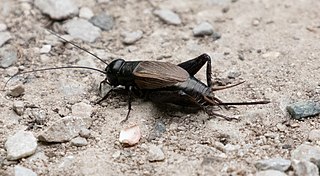Related Research Articles

Behavioral ecology, also spelled behavioural ecology, is the study of the evolutionary basis for animal behavior due to ecological pressures. Behavioral ecology emerged from ethology after Niko Tinbergen outlined four questions to address when studying animal behaviors: What are the proximate causes, ontogeny, survival value, and phylogeny of a behavior?

Gryllinae, or field crickets, are a subfamily of insects in the order Orthoptera and the family Gryllidae.

Hyla is a genus of frogs in the tree frog family Hylidae. As traditionally defined, it was a wastebasket genus with more than 300 species found in Europe, Asia, Africa, and across the Americas. After a major revision of the family, most of these have been moved to other genera so that Hyla now only contains 17 extant (living) species from Europe, northern Africa and Asia. The earliest known fossil member of this genus is †Hyla swanstoni from the Eocene of Saskatchewan, Canada, but its designation to Hyla happened before the major revision, meaning that its position needs confirmation.

Ormia ochracea is a small yellow nocturnal fly in the family Tachinidae. It is notable for its parasitism of crickets and its exceptionally acute directional hearing. The female is attracted to the song of the male cricket and deposits larvae on or around him, as was discovered in 1975 by the zoologist William H. Cade.

The northern cricket frog is a species of small hylid frog native to the United States and northeastern Mexico. These frogs are majorly in grey, green, and brown color with blotching patterns. Many have a brown or orange stripe down the center of their back and a triangular marking on the top of their head. Despite being members of the tree frog family, they are not arboreal. These frogs prefer habitats near the edges of slow-moving bodies of water, and in close proximity to shelter items, like rocks. It has two recognized subspecies, A. c. crepitans and A. c. paludicola.

Teleogryllus oceanicus, commonly known as the Australian, Pacific or oceanic field cricket, is a cricket found across Oceania and in coastal Australia from Carnarvon in Western Australia and Rockhampton in north-east Queensland
A mating call is the auditory signal used by animals to attract mates. It can occur in males or females, but literature is abundantly favored toward researching mating calls in females. In addition, mating calls are often the subject of mate choice, in which the preferences of one gender for a certain type of mating call can drive sexual selection in a species. This can result in sympatric speciation of some animals, where two species diverge from each other while living in the same environment.

Gryllus pennsylvanicus is known as the fall field cricket. G. pennsylvanicus is common in southern Ontario, is widespread across much of North America and can be found even into parts of northern Mexico. It tends to be absent in most of the southwestern United States including southern California. Within its geographic range this field cricket will burrow into soil in fields and forest edges. Individuals inhabit grassy disturbed areas and are often found around areas of human habitation.

Gryllus veletis, commonly known as the spring field cricket, is abundant throughout eastern North America. G. veletis is a solitary, aggressive, omnivorous, burrow-inhabiting species of cricket. This species is commonly confused with Gryllus pennsylvanicus, as they inhabit the same geographical area. However, the two species are easily distinguished through examination of life history, ovipositor and behavioural differences. Predators of G. veletis include American toads, wild turkeys, red-tailed hawks, wolf spiders and red-backed salamanders.

Crickets are orthopteran insects which are related to bush crickets, and, more distantly, to grasshoppers. In older literature, such as Imms, "crickets" were placed at the family level, but contemporary authorities including Otte now place them in the superfamily Grylloidea. The word has been used in combination to describe more distantly related taxa in the suborder Ensifera, such as king crickets and mole crickets.

Gryllus is a genus of field cricket. Members of the genus are typically 15–31 mm long and darkly coloured. The type species is Gryllus campestris L.: the European field cricket.
Platygryllus is a genus of crickets in the subfamily Gryllinae. Records of species distribution include Africa, southern Europe and in Asia: India, Java and the Philippines.

Gryllus texensis is a species of cricket described by William H. Cade and Otte in (2000). Cade and Otte clarify that field crickets collected in the Southeastern United States from Florida to Texas identified as Gryllus integer, were in fact misidentified, and should have been classified as G. texensis. Morphologically, Cade and Otte found no differences between G. texensis and Gryllus rubens, however, their call song structure was significantly different.

Gryllus rubens, commonly known as the southeastern field cricket, is one of many cricket species known as a field cricket. It occurs throughout most of the Southeastern United States. Its northern range spans from southern Delaware to the extreme southeastern corner of Kansas, with a southern range stretching from Florida to eastern Texas.

Marlene Zuk is an American evolutionary biologist and behavioral ecologist. She worked as professor of biology at the University of California, Riverside (UCR) until she transferred to the University of Minnesota in 2012. Her studies involve sexual selection and parasites.
An illegitimate receiver is an organism that intercepts another organism's signal, despite not being the signaler's intended target. In animal communication, a signal is any transfer of information from one organism to another, including visual, olfactory, and auditory signals. If the illegitimate receiver's interception of the signal is a means of finding prey, the interception is typically a fitness detriment to either the signaler or the organism meant to legitimately receive the signal, but it is a fitness advantage to the illegitimate receiver because it provides energy in the form of food. Illegitimate receivers can have important effects on the evolution of communication behaviors.
Gryllus integer, commonly known as the western trilling cricket, is one of many species of field cricket in the genus Gryllus. It is called the "triller" field cricket because its song is nearly continuous rather than broken into discrete chirps. G. integer can be found in parts of the Western United States, having been recorded from Oregon, California, Arizona and New Mexico.
Rohini Balakrishnan is an Indian bioacoustics expert. She is a senior Professor and Chair of the Centre for Ecological Sciences at the Indian Institute of Science (IISc), Bengaluru. Her research focuses on animal behavior through the lens of animal communication and bioacoustics.
Condition-dependent signaling is a component of sexual selection. Its exact definition remains elusive due to the vagueness of the terms "condition" and "signaling". It examines which conditions favor the extravagant displays and ornaments, or signals, some organisms poses, despite their lack of evolutionary value in terms of fitness.
The sensory trap hypothesis describes an evolutionary idea that revolves around mating behavior and female mate choice. It is a model of female preference and male sexual trait evolution through what is known as sensory exploitation. Sensory exploitation, or a sensory trap is an event that occurs in nature where male members of a species perform behaviors or display visual traits that resemble a non-sexual stimulus which females are responsive to. This tricks females into engaging with the males, thus creating more mating opportunities for males. What makes it a sensory trap is that these female responses evolved in a non-sexual context, and the male produced stimulus exploits the female response which would not otherwise occur without the mimicked stimulus.
References
- ↑ "Buffalo teacher a finalist for science group award". The Buffalo News. 1995-02-17. p. 35. Retrieved 2023-12-28.
- ↑ "Bill & Elsa Cade". Calgary Herald. 2010-11-11. p. 78. Retrieved 2023-12-28.
- ↑ Cactus Yearbook. Austin, TX: University of Texas. 1968. p. 490.
- ↑ Cade, W. H. 1975. Acoustically orienting parasitoids: Fly phonotaxis to cricket song. Science 190: pp. 1312-1313.
- ↑ "Crickets on Mute: Hush falls as killer fly stalks singers". September 20, 2006.
- ↑ Male mating success, calling and searching behavior at high and low density in the field cricket, Gryllus integer William H. Cade & Elsa Salazar Cade, Animal Behavior, 1992, pp. 43, 49-56.
- ↑ Alternation calling and spacing patterns in the field cricket Acanthogryllus fortipes (Orthoptera; Gryllidae). William H. Cade and Daniel Otte, Canadian Journal of Zoology, pp. 2916-2920